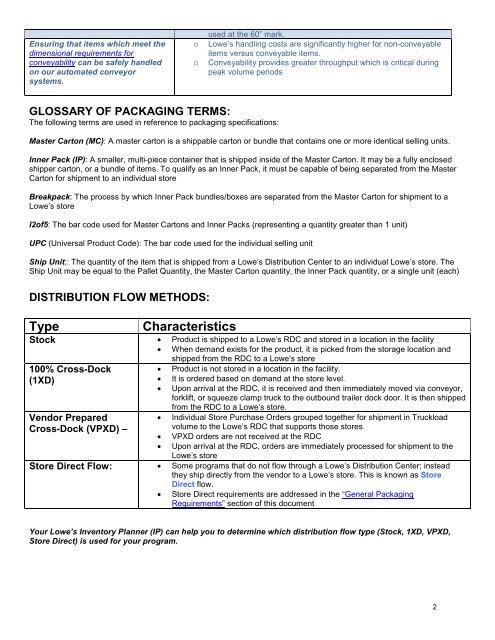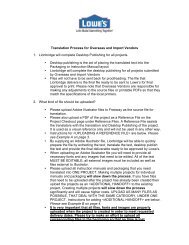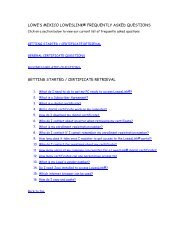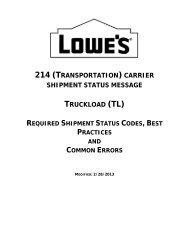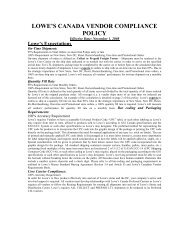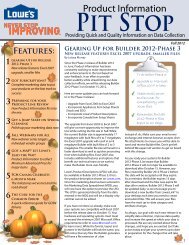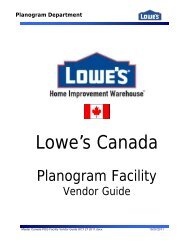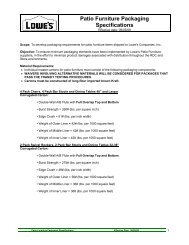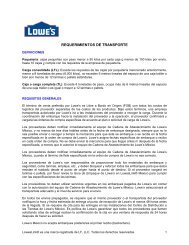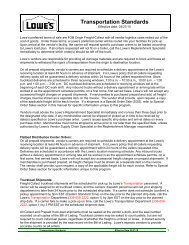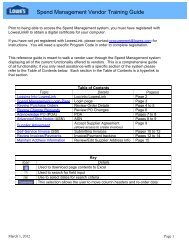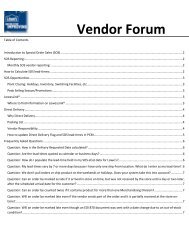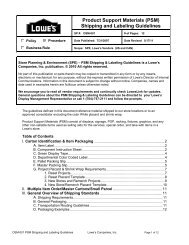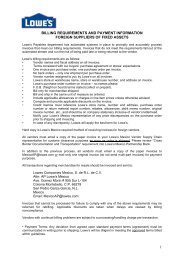Domestic Packaging Guidelines for RDC & Store Direct ... - LowesLink
Domestic Packaging Guidelines for RDC & Store Direct ... - LowesLink
Domestic Packaging Guidelines for RDC & Store Direct ... - LowesLink
- No tags were found...
You also want an ePaper? Increase the reach of your titles
YUMPU automatically turns print PDFs into web optimized ePapers that Google loves.
Ensuring that items which meet thedimensional requirements <strong>for</strong>conveyability can be safely handledon our automated conveyorsystems.ooused at the 60” mark.Lowe’s handling costs are significantly higher <strong>for</strong> non-conveyableitems versus conveyable items.Conveyability provides greater throughput which is critical duringpeak volume periodsGLOSSARY OF PACKAGING TERMS:The following terms are used in reference to packaging specifications:Master Carton (MC): A master carton is a shippable carton or bundle that contains one or more identical selling units.Inner Pack (IP): A smaller, multi-piece container that is shipped inside of the Master Carton. It may be a fully enclosedshipper carton, or a bundle of items. To qualify as an Inner Pack, it must be capable of being separated from the MasterCarton <strong>for</strong> shipment to an individual storeBreakpack: The process by which Inner Pack bundles/boxes are separated from the Master Carton <strong>for</strong> shipment to aLowe’s storeI2of5: The bar code used <strong>for</strong> Master Cartons and Inner Packs (representing a quantity greater than 1 unit)UPC (Universal Product Code): The bar code used <strong>for</strong> the individual selling unitShip Unit:: The quantity of the item that is shipped from a Lowe’s Distribution Center to an individual Lowe’s store. TheShip Unit may be equal to the Pallet Quantity, the Master Carton quantity, the Inner Pack quantity, or a single unit (each)DISTRIBUTION FLOW METHODS:TypeCharacteristicsStock • Product is shipped to a Lowe’s <strong>RDC</strong> and stored in a location in the facility• When demand exists <strong>for</strong> the product, it is picked from the storage location andshipped from the <strong>RDC</strong> to a Lowe’s store100% Cross-Dock(1XD)Vendor PreparedCross-Dock (VPXD) –• Product is not stored in a location in the facility.• It is ordered based on demand at the store level.• Upon arrival at the <strong>RDC</strong>, it is received and then immediately moved via conveyor,<strong>for</strong>klift, or squeeze clamp truck to the outbound trailer dock door. It is then shippedfrom the <strong>RDC</strong> to a Lowe’s store.• Individual <strong>Store</strong> Purchase Orders grouped together <strong>for</strong> shipment in Truckloadvolume to the Lowe’s <strong>RDC</strong> that supports those stores.• VPXD orders are not received at the <strong>RDC</strong>• Upon arrival at the <strong>RDC</strong>, orders are immediately processed <strong>for</strong> shipment to theLowe’s store<strong>Store</strong> <strong>Direct</strong> Flow: • Some programs that do not flow through a Lowe’s Distribution Center; insteadthey ship directly from the vendor to a Lowe’s store. This is known as <strong>Store</strong><strong>Direct</strong> flow.• <strong>Store</strong> <strong>Direct</strong> requirements are addressed in the “General <strong>Packaging</strong>Requirements” section of this documentYour Lowe’s Inventory Planner (IP) can help you to determine which distribution flow type (Stock, 1XD, VPXD,<strong>Store</strong> <strong>Direct</strong>) is used <strong>for</strong> your program.2


